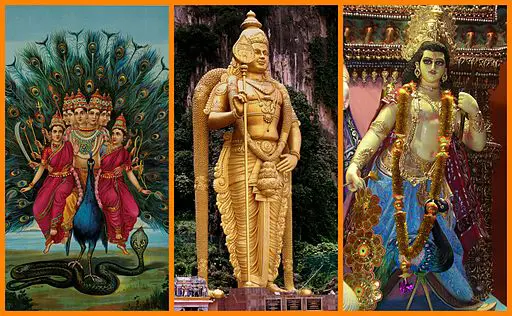Skanda, also known as Karttikeya, Kumara, or Subrahmanya, is the Hindu god of war and the firstborn son of Shiva.
He is also known as Murugan in Southern India and Dravidian Literature.
The many legends giving the circumstances of his birth are often at variance with one another. In most versions of the story, the gods wished for Skanda to be born in order to destroy the demon Taraka, who had been granted a boon that he could be killed only by the son of Shiva.
Skanda was reared by the Krittikas, six stars that make up the Pleiades and are the wives of the sage stars who constitute the constellation Ursa Major. Hence, Skanda is also called Karttikeya (“Son of Krittikas”).
He developed his six faces to drink the milk of his six nurses. His relationship with Parvati is also acknowledged, and he is often depicted in painting and sculpture as a six-headed child held by his mother, Parvati, and accompanied by his brother Ganesha.
He is called Kumara (Sanskrit: “Youth,” “Boy”) because he is generally considered to have never married. He has enormous strength and leads the army of the gods.
The Skanda Purana is the largest of the eighteen major Puranas, containing over 81,000 verses.
It is part of the Kaumara literature, named after Skanda, a son of Shiva and Parvati, who is also known as Murugan in Southern India and Dravidian Literature.
The text has been an important historical record and influence on the Hindu traditions and rituals related to the war-god Skanda. The earliest version of the Skanda Purana probably existed by the 8th century CE, but the Skanda Purana that has survived into the modern era exists in many versions.
It is considered as a living text, which has been widely edited, over many centuries, creating numerous variants.
The common elements in the variant editions encyclopedically cover cosmogony, mythology, genealogy, dharma, festivals, gemology, temples, geography, discussion of virtues and evil, theology, and of the nature and qualities of Shiva as the Absolute and the source of true knowledge.
The editions of the Skanda Purana text also provide an encyclopedic travel handbook with meticulous Tirtha Mahatmya (pilgrimage tourist guides), containing geographical locations of pilgrimage centers in India, Nepal, and Tibet, with related legends, parables, hymns, and stories.
How is Skanda worshipped today?
One of the ways he is worshipped is through the observance of Skanda Shashti, a monthly festival dedicated to Lord Murugan.
The festival is celebrated on the Panchami (fifth day) or the Sashti Tithi (sixth day) of Shukla Paksha (waxing phase of the Moon) every month.
The Shukla Paksha Sashti Tithi marks Lord Murugan’s triumph over a demon named Soorapadman.
On this day, Lord Murugan devotees observe a fast, consume meal only once during the day, pray to the deity by bowing before him, and offer their sincere prayers.
They also chant sacred mantras dedicated to Lord Murugan such as Sharavana Bhava Mantra and Murugan Gayatri Mantra.
There are also certain rules of worship and a list of Dos and Don’ts that devotees follow during this festival. For example, speaking ill of others is totally forbidden and devotees are encouraged to recite various inspiring hymns and read stories connected with Lord Subramanya.
Skanda is also worshipped in other ways such as through daily prayers, offerings, and visits to temples dedicated to him. He is an important deity in Hinduism and his worship continues to be an integral part of the faith today.
Image credit
Ms Sarah Welch, CC BY-SA 4.0, via Wikimedia Commons